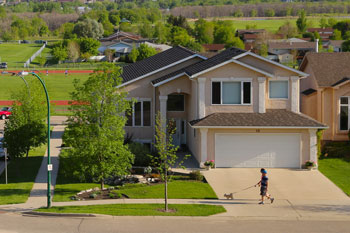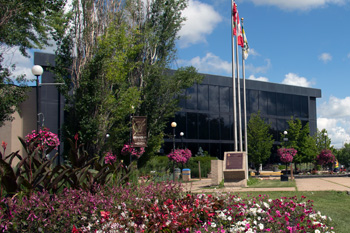Street classifications are intended to allow a road network to perform efficiently and safely from both traffic operations and road safety perspectives. This objective is achieved by the designation and operation of roadways to their intended purposes. Classifications group roads according to the type of service each group is intended to provide and are a fundamental tool for asset management. Typically, urban roadways are grouped into four major hierarchical categories: local streets, collector streets, arterial streets and expressways. Local street traffic is collected by collector roadways, which provide access to arterials, which may then connect to expressways. Grouping roads with similar functions can improve transportation planning, geometric design, maintenance and operations. Road classification systems may also aid in managing urban development and access control.
The Transportation Association of Canada specifies various characteristics associated with the classification of a roadway. These characteristics include service function, land service, traffic volume, flow characteristics, design and average running speed, vehicle type and normal connections. Speed limits, traffic volumes and flow characteristics tend to be higher on higher level roadways such as expressways.
Road classifications assist with the establishment of right-of-way widths, cross-sections, pavement structures, drainage systems, and sidewalks. The co-ordination of traffic control guidelines, pavement markings and speed limits is also aided by road classifications. The Engineering Department for the City has a transportation focus of providing local and commuter traffic as well as freight goods movements within a safe, affordable and efficient road network in the City of Brandon.
City of Brandon Street Classifications
The City of Brandon has a designated system of collector and arterial roads, as identified on this web page as well as maps found in the City of Brandon Traffic By-Law No. 5463. As of 2006, there are over 320 kilometres of roads within the City of Brandon limits, including approximately 67 kilometres of arterials, 55 kilometres of collectors, and 200 kilometres of local streets.
Brandon has a number of key routes classified as arterials within the City. Examples of these routes are 1st Street, 18th Street, PTH 1A, PTH 110, Victoria Avenue and Richmond Avenue. These routes have been treated as major thoroughfares for commuter, local and truck traffic within the city. Arterials intersect with other arterials and collectors, and collectors intersect with local streets and lanes. The traffic flow on arterials is typically uninterrupted except at intersections and crosswalks.
The Brandon and Area Planning District Development Plan (April 2006), Section 13.2.3 System of Urban Roadways, classifies roads into the following categories:
- Expressways intended to handle high speed traffic around the City for the efficient movement of people and goods;
- Arterial streets intended to accommodate large volumes of traffic with a high level of safety and efficiency;
- Collector streets intended to accommodate moderate volumes of traffic travelling at moderate speeds;
- Local streets intended to provide for vehicular access to individual building lots and which accommodate low volumes of traffic traveling at low speeds; and
- Public lanes intended to provide for vehicular access to individual properties at locations where it is inappropriate to provide access from a street.
Street Classification Guidelines
| Traffic Function | Arterial: Through traffic, restricted land access | Collector: Through traffic & land access | Local: Land Access |
| Traffic Volumes (vpd)* | Arterial: 5,000 - 30,000 | Collector: < 10,000 | Local: < 1500 |
| Design Speed (km/h) | Arterial: 60 - 100 | Collector: 50 - 70 | Local: 50 - 60 |
| Basic # of Lanes | Arterial: 2 or 4 | Collector: 2 or 4 | Local: 2 |
| Access Control | Arterial: Restriced access | Collector: Access with some restriction | Local: Access with few restrictions |
| Intersection Spacing | Arterial: 400 m | Collector: 60 m | Local: 60 m |
| Right-of-Way | Arterial: 20 - 40 m | Collector: 20 - 32 m | Local: 16 - 20 m |
*vpd - vehicles per day
Street Classification Guideline Map
![]() Street Classifications Drawing (732 KB)
Street Classifications Drawing (732 KB)







